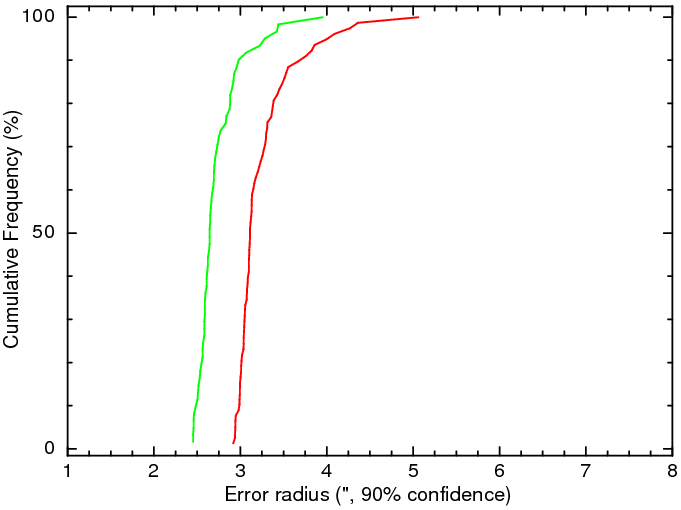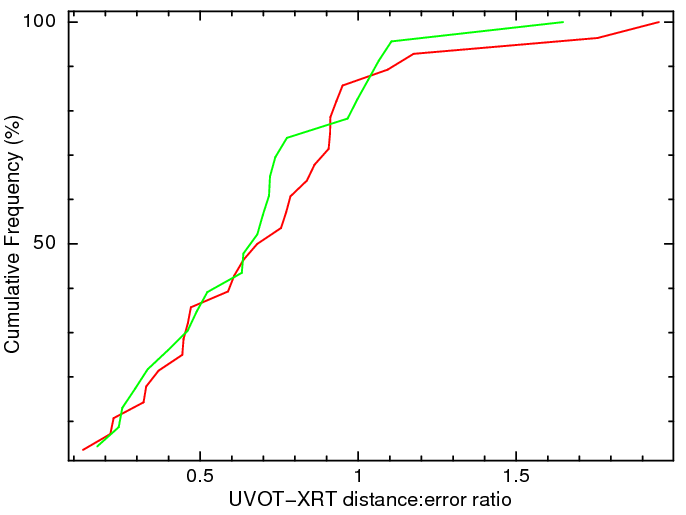- Home
- About
- Support
- Data Access
- Data Analysis
- Data Products
- Publications
-
Links
Databases NED Simbad GCN circulars archive GRB data table Software & Tools Swift Software (HEASoft) Xanadu WebPIMMS Institutional Swift Sites GSFC PSU OAB SSDC MSSL University of Leicester
Swift-XRT prompt-ground GRB positions
Introduction
Among the products promptly telemetered to the ground by Swift via TDRSS when observing a newly-detected burst, are the X-ray Single Pixel Event Report, or SPER, data. These contains single pixel (grade 0) events above 0.5 keV, detected in the central 200x200 pixel window of the XRT in Photon Counting mode. They are used to generate a position for the new GRB when automatic onboard centroiding failed, or to refine the onboard position. SPER messages are telemetered periodically, so there can be multiple SPERs per burst. These are not cumulative, and are summed before being analysed.
Software at the UKSSDC is automatically triggered whenever SPER data are received. This combined all available SPER data and detects and localises the GRB afterglow. These SPER positions, or Prompt-ground positions (the two terms are interchangeable) are more reliable than on-board derived or ground image mode derived positions, as the SPER analysis takes account of bad columns and the Point Spread Function (PSF). Where possible, we apply the enhancement process (see below), which further improves the positions. SPER positions are produced for approximately 75% of BAT-detected GRBs with prompt slews.
Algorithm
When a SPER message is received, the software checks to see if any earlier SPER messages for that trigger exist, and, if so, merges them all to create a single event list, and creates an image from this. A sliding-cell source search mechanism is then employed, which searches for count excesses above the background. Any excesses thus found are assumed to be sources. In the very rare case where multiple sources are found in the SPER data (this has happened once to date), the brightest source is assumed to be the GRB and this position is processed as described below, however positions for all sources are sent to the XRT team for consideration.
For each source, a PSF fit is used to determine the centroid position and 90% confidence error radius. The centroiding mechanism uses the method described in Cash (1978) to fit the Swift PSF to the data and determine a position and uncertainty. The PSF calculation takes into account the bad columns on the detector, so the position is reliable even when the source lies over these columns. The PSF used for the fit assumes that the source is not piled up. If this is not true, the error in the position is increased slightly. Many simulations have been carried out verifying that this error has been accurately determined.
If UVOT data has also been received via TDRSS, an attempt is made to enhance the SPER position. When UVOT takes its initial exposures, a source list is produced onboard Swift and telemetered to the ground. For each of these we use the known mapping between the XRT and UVOT to convert the XRT position into an equivalent UVOT position (which is UVOT filter dependent). Then the UVOT sources are compared to the USNO-B1 catalogue, and an aspect solution is found, which is used to correct the XRT position. If more than one UVOT source list was available, multiple positions will thus be produced. The weighted mean is thus taken, the statistical error in the XRT position is factored in, as are the systematic errors (see the Verification section) to give the UVOT enhanced SPER position
Approximately 75% of SPER positions can be UVOT enhanced. For the other 25%, the attitude information available through TDRSS does not cover times at which the UVOT data were taken or there were no UVOT data. For these GRBs the position we report is that obtained from the PSF fit, with the necessary systematic error included (see Verification, below).
Dissemination of results
Once a position is determined, it is immediately posted on the SPER results page. Enhanced positions have a green background, standard positions, a white one. The position is also given in the first GCN circular announcing the burst.
Either as soon as a UVOT-enhanced SPER position is produced, or once the second SPER message has been processed and an unenhanced position found, a GCN position notice will automatically be dispatched. If a previous position notice for this burst has been circulated, the UPDATE_FLAG field (225 bit for socket connections) will be set to 1. If no second SPER is received within 9 minutes of the first (and the position was unenhanced) the position from the first SPER will be sent as a notice.
Occasionally, the GCN circular announcing the new burst may be produced by the Swift team before a SPER position was determined (for example, if the X-ray source was bright enough to keep XRT in Windowed Timing mode for a long time). In such cases, if an enhanced SPER position is subsequently produced, and no UVOT position (which will always be better than an XRT position) exists, a GCN circular will automatically be dispatched, giving the enhanced SPER position.
Position Accuracy Verification
To verify the accuracy of these positions we compared them with the UVOT positions of GRBs, for those bursts with both SPER positions and UVOT afterglow localisations. For the enhanced positions we found 80% agreement between the two, suggesting that our initial 90% error was underestimated. Adding a further systematic error of 1.7′′ in quadrature was necessary to achieve 90% agreement, thus all of our enhanced positions now have this extra systematic included.
We performed the same test on the unenhanced positions. We included the unenhanced positions for those GRBs where an enhanced position had been found, to give better statistics. This showed that the unenhanced positions require an systematic error of 2.9′′, less than the 3.5′′ systematic error associated with the star trackers. This improvement arises because our PSF fitting corrects for the bad columns, whereas the boresight uncertainty was calculated using a barycentric fit, which does not.
Precision
The plot below shows the cumulative frequency distribution of the SPER 90% confidence error radius. The red curve shows the standard SPER positions, and the green curve shows the UVOT-enhanced SPER positions (the systematic error components are included). The unenhanced position errors are <3.1′′ 50% of the time, and <3.7′′ 90% of the time. For the enhanced positions, these numbers are 2.6′′ and 3.0′′

The following plot demonstrates that the error radii are correctly calibrated. For each GRB with a SPER position and a UVOT position, we determined the offset between the two, and divided this by the 90% error in each position, added in quadrature. Where this ratio is 1 or less, the two positions agree. As can be seen below, we find 90% agreement for both unenhanced positions (red) and enhanced ones (green).

